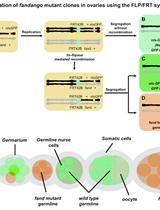- EN - English
- CN - 中文
Synthetic Lethality Screens Using RNAi in Combination with CRISPR-based Knockout in Drosophila Cells
在果蝇细胞中利用RNAi联合基于CRISPR的基因敲除技术进行协同致死筛选
(*contributed equally to this work) 发布: 2017年02月05日第7卷第3期 DOI: 10.21769/BioProtoc.2119 浏览次数: 11659
评审: Jihyun KimSteve JeanChunjing Qu
Abstract
A synthetic lethal interaction is a type of genetic interaction where the disruption of either of two genes individually has little effect but their combined disruption is lethal. Knowledge of synthetic lethal interactions can allow for elucidation of network structure and identification of candidate drug targets for human diseases such as cancer. In Drosophila, combinatorial gene disruption has been achieved previously by combining multiple RNAi reagents. Here we describe a protocol for high-throughput combinatorial gene disruption by combining CRISPR and RNAi. This approach previously resulted in the identification of highly reproducible and conserved synthetic lethal interactions (Housden et al., 2015).
Keywords: Synthetic lethality (协同致死)Background
Knowledge of genetic interactions such as synthetic lethality can be invaluable for determining the functional relationships between genes. For example, large scale genetic interaction screens in yeast were recently used to assemble a global ‘wiring diagram of cellular function’ (Costanzo et al., 2016). Alternatively, specific types of genetic interaction such as synthetic lethal interactions can be used to identify drug targets for diseases including cancer (Kaelin, 2005).
Identification of synthetic interactions requires combinatorial disruption of two genes. A previous method to achieve this in Drosophila cell culture was to deliver multiple dsRNA reagents simultaneously (e.g., Fisher et al., 2015). However, RNAi reagents have limitations including off-target effects and incomplete target knockdown, which are compounded when multiple reagents are delivered together. By combining CRISPR mutagenesis with single dsRNA treatments, these issues are avoided, leading to simpler interpretation of screen results and robust identification of ‘hits’.
Materials and Reagents
- 10 cm dish (e.g., Corning, catalog number: 430167 )
- T75 flasks (Corning, catalog number: 430641U )
- 0.2 μm filter (Thermo Fisher Scientific, catalog number: 156-4020 )
- 6-well tissue culture plates (Corning, catalog number: 3516 )
- 96-well clear bottom tissue culture plates (Corning, catalog number: 3610 )
- 40 μm cell strainer (Corning, Falcon®, catalog number: 352340 )
- Parafilm (Parafilm, catalog number: PM-999 )
- 24-well plate
- 15 ml conical tube
- Tips
- S2R+ cells (Drosophila Genomics Resource Center, catalog number: 150 )
- sgRNA expression plasmid (pl18 - available from author on request)
- act-GFP plasmid (available from author on request)
- Chemically competent E. coli cells (e.g., Thermo Fisher Scientific, InvitrogenTM, catalog number: C404003 )
- Effectene Transfection Reagent Kit (QIAGEN, catalog number: 301427 )
- PBS (Thermo Fisher Scientific, GibcoTM, catalog number: 10010023 ) with 1% FBS (GE Healthcare, HyCloneTM, catalog number: SH30541.03 )
- HRMA reagents (Housden and Perrimon, 2016)
- Zero-Blunt TOPO PCR Cloning Kit (Thermo Fisher Scientific, InvitrogenTM, catalog number: 450245 )
- M13F and M13R primers
- dsRNA library in 384-well opaque, white tissue culture plates with 5 μl dsRNA at 50 ng/μl per well (see the Drosophila RNAi Screening Center [http://fgr.hms.harvard.edu/fly-cell-rnai-libraries] for available libraries). Note that this protocol focuses on dsRNA libraries available from the DRSC but additional libraries are also available from other sources.
- CellTiter-Glo reagent (Promega, catalog number: G7570 )
- Schneider’s Drosophila media (Thermo Fisher Scientific, GibcoTM, catalog number: 21720 )
- Penicillin/streptomycin (Thermo Fisher Scientific, Invitrogen, catalog number: 15070063 )
- Complete media (10% FBS) (see Recipes)
- High-serum media (20% FBS) (see Recipes)
- Serum-free Schneider’s media (see Recipes)
Equipment
- 10 ml pipette
- Humidity chamber (a tupperware box lined with damp paper towels is fine)
- 25 °C cell culture incubator (any brand – CO2 regulation is not necessary)
- Microscope (e.g., Leica Microsystems, model: DMIL , with 10x objective and any brand of camera)
- 12-channel 100 μl pipette (e.g., Thermo Labsystems)
- 12-channel 10-50 μl pipette (e.g., Thermo Labsystems)
- Centrifuge with plate-compatible rotor (any brand)
- Pasteur pipette
- Haemocytometer (any brand)
- Multichannel reservoir
- Timer
- Rotator
- Plate reader with luminescence reading capability (e.g., Molecular Devices, model: SpectraMax Paradigm )
- Fluorescence-activated cell sorter (e.g., BD FACSAria)
- Thermal cycler (any brand)
Procedure
文章信息
版权信息
© 2017 The Authors; exclusive licensee Bio-protocol LLC.
如何引用
Housden, B. E., Nicholson, H. E. and Perrimon, N. (2017). Synthetic Lethality Screens Using RNAi in Combination with CRISPR-based Knockout in Drosophila Cells. Bio-protocol 7(3): e2119. DOI: 10.21769/BioProtoc.2119.
分类
分子生物学 > RNA > 转染
细胞生物学 > 基于细胞的分析方法 > 基因表达
分子生物学 > DNA > 诱/突变
您对这篇实验方法有问题吗?
在此处发布您的问题,我们将邀请本文作者来回答。同时,我们会将您的问题发布到Bio-protocol Exchange,以便寻求社区成员的帮助。
Share
Bluesky
X
Copy link













